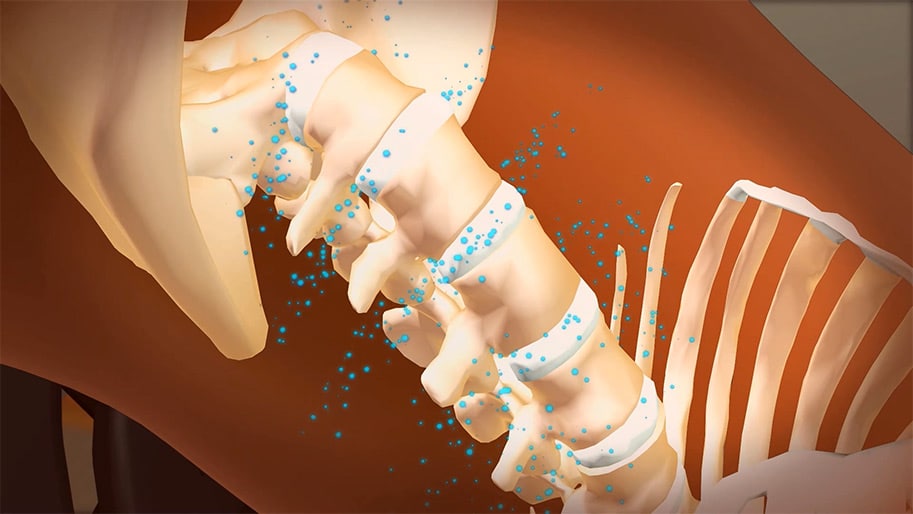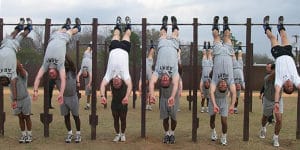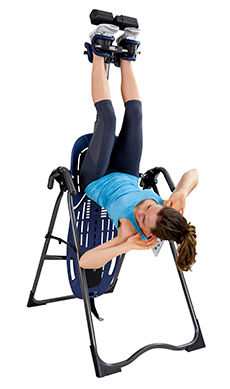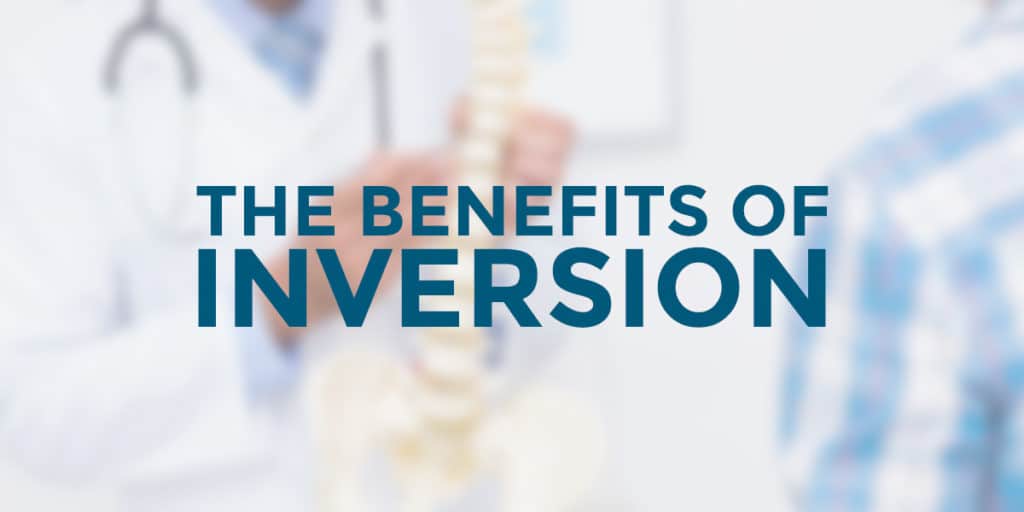Don’t just cover up symptoms; target the source of your ache! Teeter Inversion Tables have helped millions like you find natural relief in the convenience of their own homes, and takes only a few minutes a day!
Relieve Back Pain
Unlike surgery, mechanical traction, and other invasive forms of treatment, using a Teeter is a gentle, passive way to target pain at the source and care for all weight-bearing joints. This progressive form of traction allows each joint to be decompressed by the same weight that compresses it while upright.
To put it simply, inverted decompression creates an ideal stretch that improves spinal health and targets back pain by helping to:
- 1. Rehydrate discs
- 2. Reduce nerve pressure
- 3. Realign the spine
- 4. Relax tense muscles
The benefits extend beyond just spinal health and pain relief though, also helping to:
- 5. Ease stress
- 6. Improve joint health
- 7. Increase flexibility
- 8. Improve fitness & build core strength
Best of all, decompressing on a Teeter takes only a few minutes and feels great!
1) Rehydrate discs

When you are sitting, standing, exercising, or doing other weight-bearing activities, fluid is squeezed out of your discs and into adjacent soft tissue, just as moisture can be squeezed out of a sponge. As a result, your discs lose some of their height. To prove this fact, measure yourself in the morning and then again at night. You will lose half-an-inch to three-fourths-of-an-inch in height by the end of the day.
When you are lying down the compression in the spine is reduced enough to allow the discs to slowly reabsorb moisture and nutrition over the many hours you sleep. However, the discs may not always maintain their full height capacity, creating a total accumulation of height loss of up to two inches in a lifetime.
The Nachemson study provides some insight: A number of volunteers permitted a pressure sensor to be surgically implanted inside the third lumbar disc. The pressure inside the disc in the standing position was set at a baseline of 100% and all other body positions compared to it.
Interestingly one of the most compressive activities for the discs is sitting. The muscles in the stomach and back relax, but the pressure in the spine increases. If you are sitting in poor posture the pressure in the lumbar can climb as high as 250%. The real surprise occurred while lying down. The pressure inside the disc only lost 75% of standing body weight – it never went below 25%! This residual compression seems to be due to the hundreds of ligaments and muscles that encase the spine, holding it in compression like a mass of rubber bands.
This study further indicated that the amount of traction force required to overcome the compression was a large number, approximately 60% of your body weight. Inversion to an angle of about 60 degrees is the only practical way to offset that much gravity force while remaining relaxed.
2) Reduce nerve pressure
The height of the discs relates to the size of the passageway for the nerve roots to exit from the spinal column, so a plump hydrated disc creates maximum clearance, helping to alleviate pressure or pinching of the nerve root.
A bundle of nerves called the spinal cord run through the spinal column; these nerves control communication from the brain to the rest of the body. Nerve roots exit between the vertebrae along the length of the spine in the passageway created by the discs. Damage to the discs or de-hydration/degeneration of the discs can result in nerve root entrapment, or what is commonly called a pinched nerve.
Since the nerves extend into the body there can be pain that radiates to extremities. Through the increased hydration to the discs during inversion the discs plump in height, effectively increasing the separation between the vertebra and reducing the pressure and pinching on nerve roots.
3) Realign the spine

Also, many of our most popular sports are one-sided and rotational, like golf, squash, tennis, which puts significant stress on the spine as well as develops muscles on a single side of the body.
Misalignment means that the body weight is no longer supported by an alignment of bones, and therefore the soft tissue of the body must resist gravity.
Misalignment is not always felt on the inside but left alone it can cause visual changes to your posture, and those changes can be degenerative. If you want to test this at home, take an empty aluminum can and place pressure on the top. The can will be able to maintain its shape even with great force applied because the sides are in alignment, but add a small dent to the can and it will crumble under half the amount of pressure.
Learn more from a chiropractor’s point of view on inversion
When a vertebra is bumped out of alignment the ligaments and muscles that support the spine can hold it in misalignment through the compression that they generate. Since these ligaments and muscles are engaged even when lying down, creating pressure as much as 25% compared to 100% standing, it can be difficult for the spine to naturally come back into alignment.
When inverted to 60 degrees the pressure in the spine drops to zero, as shown in the Nachemson medical study, with the pressure off of the vertebrae and with some gentle stretching the vertebra has the opportunity to move back into alignment.
4) Relax tense muscles
Muscles are gently stretched as circulation is increased, helping to reduce tension.
A study conducted by physiotherapist L.J. Nosse found that EMG activity (a measure of muscle tension), declined over 35% within 10-seconds of inversion, the effect was found to start at the very shallow angle of 25 degrees.
It is suggested that the stretch to the muscles while inverted allowed the circulation to enter the sore muscle, bringing oxygen-rich blood inversion therapy also stimulated the lymph system to clear the muscle of the toxin build-up. The user, therefore, would feel a decrease in pain and the stiffness in the muscle would subside.
5) Ease Stress
Stress and tension can cause pain and muscle spasms in the back, neck, and shoulders, as well as headaches and other problems. Tense muscles can be attributed to misalignments of the spine, overstimulation of nerves, or poor removal of toxins by the lymphatic system and a lack of oxygen-rich circulation.
Dr. John E. Sarno, of the New York Institute for Rehabilitation Medicine, claims that in more than 90% of the patients that he sees for back pain either there is no structural abnormality or the ‘abnormal’ x-ray does not really explain the nature or location of the pain. He calls the disorder the ‘tension myositis syndrome’ and describes how the tension causes muscle pain in this way: The muscle tenses and this reduces blood flow in the muscles of the neck, shoulders, back, or the buttocks. This produces pain by allowing the accumulation of waste chemicals, much the same process that causes leg muscle fatigue after a long run because of lactic acid build up. When the muscles go into spasm in the lower back, it often leads you to believe (mistakenly) you have a disc problem.
Also, for centuries yoga practitioners have recognized the concept of turning the body upside down to find relaxation. The headstand position is a form of “postural exchange” (reversing the direction of gravity). Not everyone wants to do headstands, so inversion on Teeter equipment creates an easier alternative with the added benefit of joint decompression.
6) Improve Joint Health
Decompression aids in joint lubrication by altering the pressure and suction forces within the joint, helping to stimulate the synovial fluid that nourishes the cartilage and enhances shock absorption.

Strong ligaments and muscles are vital for proper joint support, and help to protect against injury. Even the Army has utilized Teeter EZ-Up Gravity Boots to mitigate joint fatigue injuries.
Just as you brush your teeth every day to maintain your dental health, you should attend to the health of your spine with a healthy routine. There is no miracle for back pain; pills to cover up pain do not address the issue, and surgery is a last resort option.
Teeter is an affordable, natural, and easy-to-use piece of equipment that is backed by medical studies and endorsed by millions of people just like you.
7) Increase Flexibility
Tight muscles or stiff joints can also cause imbalances, which can result in improper body mechanics and an increased likelihood of injury. Using a Teeter provides a natural stretch that gently elongates muscles and decompresses joints, enhancing muscle efficiency, and improving mobility and flexibility.
During a normal day, your joints and especially discs will lose fluid, resulting in the temporary height loss mentioned above. With the bones now closer together the range of movement is reduced. Inversion has shown to increase intervertebral separation as it reduces the pressure on the discs and helps them to re-hydrate to restore shock absorption and flexibility.
Muscles adapt to bad posture. For example, with slouching shoulders, the muscles in the chest shorten and those in the back lengthen. At some point, it feels strange to stand properly. Inversion helps realign the spine and stretch the shortened muscles, many users report that they stand ‘taller’ and straighter after just a short inversion session.
8) Improve fitness & build core strength

Most training activities designed to build core strength must be performed with great technical accuracy or they can injure the back. Inverted exercises can target every core muscle without adding risky, compressive loads to the spine.
Inverted squats on the Teeter inversion tables provide a unique leg workout, strengthening the hamstrings and quads while sculpting the glutes.
Learn more about the benefits of using a Teeter Inversion Table to prepare the body for a workout, to renew and recover after a workout, and to improve overall health.
The Teeter is so easy to use…
- Set it to your height, secure your ankles and relax. Weight displacement caused by simple arm movements give you total control over the speed and degree of rotation. Optional use of EZ-Angle rotation control allows you to pre-set maximum angle of rotation.
- Benefits start at the gentle angle of 20 degrees. Over time, work up to at least 60 degrees, where the pressure is reduced to zero and decompression happens in just minutes.
- Invert regularly! It only takes a few minutes to decompress the spine, and the stretch feels great and relaxes tired muscles. Use the Teeter several times a day to achieve maximum results.
Find Relief Now. Pay Later.
Now you can try Teeter in your own home FREE for 30-Days, 0% APR* with Affirm.
